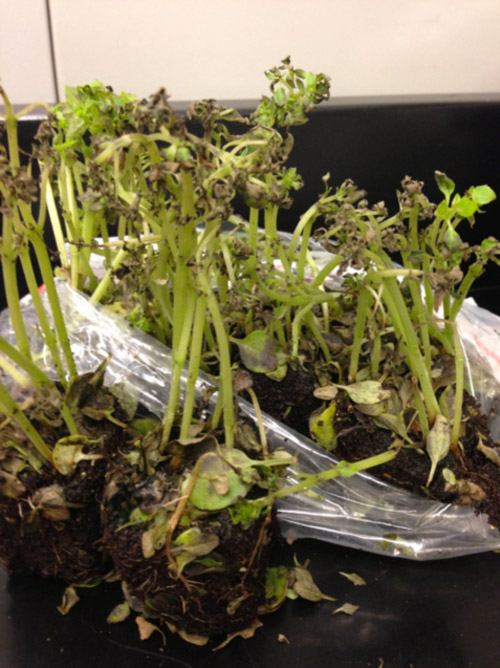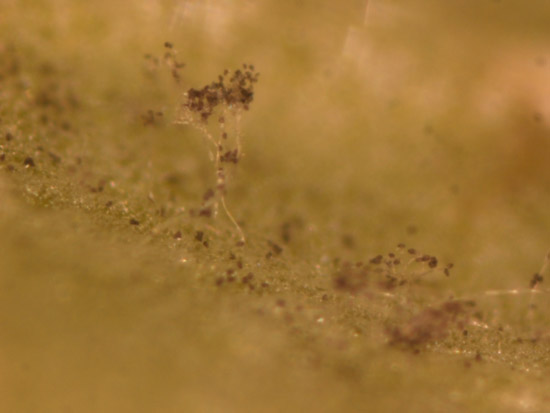Issue 4, May 20, 2013
Basil Downy Mildew
The U of I Plant Clinic recently diagnosed a basil sample with downy mildew. Dr. Mohammad Babadoost, University of Illinois Extension plant pathologist, reported that growers had first found downy mildew in Illinois on commercial basil crops in 2009. This disease can be very aggressive and can easily spread via wind-dispersed spores. It is considered to be serious because of the aggressive nature of the pathogen and that basil is considered to be a high value crop in Illinois. The total crop value of commercially grown basil in Illinois alone is approximately $10 million per year. The gross value of basil is estimated to be about $10,000 to $20,000 per acre.
Downy mildew is caused by Peronospora belbahri, a fungal-like oomycete or water mold that produces zoospores, which can be spread via wind or water. This disease pathogen also produces oospores, allowing for long term survival. It is transmitted on seed, infected plant parts, and by wind. It is suspected that this pathogen has moved geographically on contaminated seeds and leaves.
This pathogen is host specific, meaning that it only infects basil (ornamental or culinary). Dr. Babadoost has observed that all green basils appear susceptible; whereas red basils have shown to have some resistance in the field. P. belbahrii grows best under moderate to warm temperatures, but will also tolerate cooler temperatures. Unlike the downy mildew that affects lettuce and crucifers, basil downy mildew will continue to develop throughout the summer months.
Basil leaves infected with downy mildew will develop diffuse yellowing on the top of the leaf, which often occurs in sections of the leaf delineated by veins because the pathogen cannot grow past major veins in leaves. When spores are produced, a characteristic gray purple, fuzzy growth on the underside of the leaves is evident. The fuzzy growth of spores on the underside of the leaf looks as if soil had been splashed onto the leaf under-surface. The plant may also exhibit curling of lower leaves as well as brown lesions. Blackening of the affected leaf margins occurs as the disease progresses. Symptoms of downy mildew on basil can easily be mistaken for a nutritional deficiency if careful inspection of the underside of leaves is not done.



Picture of basil downy mildew sporulation on the underside of leaf -- under magnification
- Planting uninfested or disease-free basil seed -A seed testing procedure is under development.
- Selection of a less susceptible variety
- Good cultural practices to reduce humidity and leaf wetness - Good cultural practices will go a long way in helping to reduce downy mildew disease on basil. Minimizing leaf wetness and reducing humidity will aid in management as the pathogen is favored by moist conditions. This includes planting basil in full sun and where there is good air movement; maximizing plant spacing and using drip irrigation.
- Scout frequently for this pathogen. Infected basil leaves should be removed and destroyed as soon as possible to eliminate the source of inoculum for other plantings. Avoid placing infected plants into the compost pile.
- Application of fungicides - Commercial sweet basil growers will most likely need to rely on fungicides to manage the disease. Applying fungicides frequently and starting before first symptoms will be necessary. Home gardeners should inspect their basil routinely for evidence of disease and rely on cultural management as there are fewer homeowner fungicides available. This pathogen becomes resistant to fungicides fairly rapidly, so fungicide rotations with different modes of action will be necessary.
For more information about downy mildew of basil or impatiens, you can go to the Master Gardener IPM Training modules at the following link: http://mg.cropsci.illinois.edu/
(Monica David and Stephanie Porter)
Authors:
Monica David
Stephanie Porter